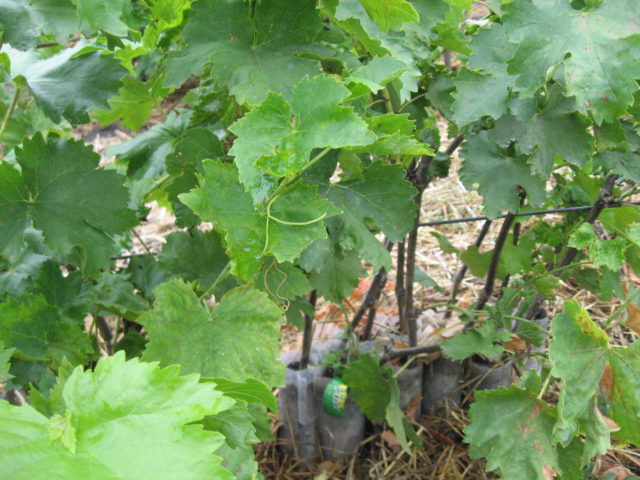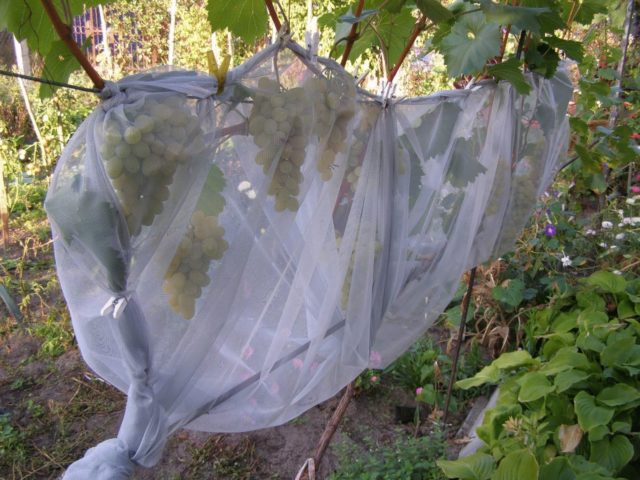 The protection of southern lianas grown in closed and open ground from large frosts is practically the same in all areas of the Central European Plain.
The protection of southern lianas grown in closed and open ground from large frosts is practically the same in all areas of the Central European Plain.
Therefore, novice gardeners can successfully apply all methods of sheltering grapes for the winter in the Urals:
- using non-woven materials;
- improvised means;
- in a polycarbonate greenhouse;
- falling asleep in the trench.
As soon as the guilt berry crop is harvested, it is necessary to carry out preparatory measures aimed at preserving the vines in the harsh winter months:
- Water bushes thoroughly.
- Spray with a weak solution of copper sulfate.
- Cut off stepsons to trunks with dense bark.
- Remove the excess length of prolific branches with a garden pruner.
[sc name = "info-dashed" text = "The length of the left lashes depends on the grape variety, you should consult a specialist about this - some varieties are cut almost to the root."]
Other species will only have to be shortened slightly and knitted in bunches in several places with a wide strip of nonwoven material before covering the grapes for the winter in the Urals. Step-by-step photos will tell novice gardeners the right ways to prepare bushes for the cold.
The easiest way to shelter
If initially the bushes were planted in deep holes, ordinary garden soil will help to keep the vine for the next harvest.
- Dig a trench of sufficient length and width along the trellis so that the formed sleeve can be laid freely on its bottom.
- Lay the connected whips in the recess and sprinkle with earth to a height of 30-40 cm.
- Leave the ends of the ditch open so that warming does not lead to the growth of mold and fungus on the branches.
After the snow falls, warm it up as high as possible on earthen shelters. If the winter is dry and precipitation does not fall, cover the ground sarcophagi with any insulation - burlap, plastic wrap, non-woven materials (spunbond or agrofibre).
[sc name = "info-hand" text = "In 1 year of planting, gardeners recommend not to carry out autumn pruning of stepchildren and leave all the lashes - future cold and difficulties in climate change will help to identify the strongest, most viable shoots of grapes."]
Air dry method
In order to prevent future cold weather from damaging a delicate plant, covering bushes is practiced, in which the branches are in a slightly suspended state:
- Along the trellis, lay wooden planks or slab floorings that have support from pieces of wooden timber.
- Tilt the branches in a bundle so that there is a distance of 10-15 cm to the decks, fasten the bushes with special studs or hooks made of steel wire.
- Put on top dried trimmings of fruit trees remaining after spring thinning of the crown.
- Cover the structure with dry sawdust or oak leaves. You can use spruce or pine legs - this will help maintain ventilation inside the shelter.
- Cover the entire structure with any insulation - roofing material, film or slate. The ends of the structure should be closed tightly only at a constant minus temperature not higher than -5.
You should not hurry with warming grapes - small frosts stimulate lignification of the bark and in winter the whips leave more seasoned.The bark is more resistant to mold and mildew than the delicate green skin of young shoots.
In the spring, with this method of warming grapes, you will have to remove only the seal, leaving sawdust and foliage on a bunch of vines. This will help the bush recover gradually and keep the plant from sunburn.

To spring the grape roots woke up faster and began to drive the juice to the branches, in the trunk area you need to dig pipes. As soon as the snow melts and a constant positive temperature is established, pour warm water into them. This recharge contributes to better tolerance of sudden frost frosts in the Urals.
How to shelter in a greenhouse?
Gardeners who do not want to depend on the surprises of the Ural summer, try to grow early varieties of vines in closed ground. Preparing for the cold in this case is somewhat lightweight in nature, as it allows you to control the situation with a higher probability of success.

Before warming the bushes in the greenhouse, standard preparation should be carried out:
- crop stepchildren;
- shorten fruiting shoots;
- feed the root system;
- spray branches with a weak solution of copper sulfate.
It is possible to warm the bushes in wet weather - the greenhouse conditions protect the plant from excessive moisture that can cause fungus or mold on the shoots:
- All bushes are tied in one bunch. If the grape has a dense tree bark, it will be difficult to tilt it to the ground, so you will have to carry out vertical insulation. To do this, it is better to use agrofibre or spunbond - they are covered with beams in 2-3 layers.
- A plastic film for vertical shelters will not work for the winter - it does not let air through and collects condensate, which is harmful in the cold for the kidneys.
- If the lashes of the plant easily lie down and do not crack at the bends, they can be tied along the lower trellis, having previously trimmed the side shoots.
Build a frame from improvised materials and pull a plastic film over it. At the same time, the ends of the shelter for grapes remain open for ventilation until constant cold weather reaches no higher than -5 degrees. Instead of a film, non-woven materials are increasingly being used that do not need an additional, rigid base.
[sc name = "info-dashed" text = "The most important thing when using polyethylene for sheltering grapes for the winter in the Urals is to prevent the vine from touching its surface."]




 Non-covering winter-hardy grape varieties for Moscow region
Non-covering winter-hardy grape varieties for Moscow region How to keep the vine in winter
How to keep the vine in winter When can I transfer grapes to another place in the fall
When can I transfer grapes to another place in the fall How to cover and prepare grapes for the winter in the suburbs
How to cover and prepare grapes for the winter in the suburbs